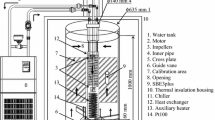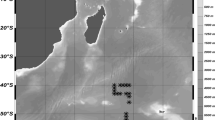Abstract
A laboratory experiment was devised and performed to investigate the pressure dependence of Sea-Bird Electronics SBE35 and SBE3 deep-ocean thermometers. The thermometers were mounted in a massive brass comparator together with a calibrated standard platinum resistance thermometer. The measurements were performed in a pressure chamber in the pressure range 0.1 MPa to 60 MPa. The results showed that both the investigated SBE35 and SBE3 thermometers are pressure dependent, with a pressure sensitivity of +41 \(\upmu \)K\(\cdot \)MPa\(^{-1}\) and \(-77\) \(\upmu \)K\(\cdot \)MPa\(^{-1}\), respectively. Nevertheless, the results obtained in only one individual device per model (one SBE35 and one SBE3) cannot be generalized and further investigations of a larger number of devices per model are needed.
Similar content being viewed by others
Avoid common mistakes on your manuscript.
1 Introduction
Approximately 93 % of the heat added to the Earth’s climate system by global warming in the last 50 years is stored in the oceans [1]. Although the strongest warming is found near the sea surface (110 mK/decade in the upper 75 m and 15 mK/decade at 700 m depth since 1971), the large volume of the deep ocean (deeper than 700 m) makes a substantial contribution (36 %) to the total energy stored in the oceans. The large inertia of the oceans implies that they naturally integrate over short-term variability and provide a clearer signal of long-term change than other components of the climate systems. Observations of ocean temperature changes therefore provide a means to track the evolution of climate change and a relevant benchmark for climate models.
However, the measurement of decadal temperature change of deep ocean sets challenging requirements for the accuracy of temperature measurements in this difficult environment (\(\approx \)1 mK/decade accuracy) [2].
Accurate deep-ocean temperature measurements are currently performed using a combination of a high-accuracy (0.2 mK claimed), high-stability (0.14 mK\(\cdot \)yr\(^{-1})\) reference thermistor (SBE35, Sea-Bird Electronics) with 0.5 s response time and a lower- accuracy (0.7 mK claimed), lower-stability (2 mK\(\cdot \)yr\(^{-1})\) thermistor (SBE3, Sea-Bird Electronics) with faster response time (70 ms), see Fig. 1.
When used in the deep ocean, the SBE3 is subject to small errors due to high pressure. The size of this effect is approximately 2 mK\(\cdot \)(60 MPa)\(^{-1}\) and is explained by the manufacturer as being due to the mechanical stress exerted on the glass encapsulated thermistor by the stainless steel needle (diameter 0.8 mm) in which the thermistor is enclosed, when the needle is compressed at high pressure.
The pressure dependence of the SBE3 has now been established [3, 4] through an in situ additional calibration of the SBE3 relative to an SBE35 [4]. However, a possible pressure dependence of the SBE35 has not yet been ruled out [5] and such eventuality makes the in situ calibration of the SBE3 with an SBE35 questionable.
In this paper, we first critically review the investigations already performed on the pressure dependence of SBE3 and SBE35 thermometers (Sect. 2), then we describe the experiment we designed and carried out to show the pressure sensitivity of both the SBE3 and the SBE35 (Sect. 3), and finally, we discuss our results in comparison with those available from the literature (Sect. 4).
2 Review of Previous Investigations
The pressure dependence of SBE35 and SBE3 has been investigated by Uchida et al. and reported in [4, 5]. In the first paper [4], the data collected in 15 cruises over 3 years were analyzed. In each cruise, a large number of casts were performed, and in each cast 2 SBE3 and 1 SBE35 were installed in the instrument frame (CTD). Over the 3-year campaign, a total of 11 SBE3 and 2 SBE35 were deployed. For each cruise and for each SBE3/SBE35 combination, the vertical (pressure) distribution of the difference between the temperature reading of the SBE3 and the temperature reading of the SBE35, \(t_{SBE3}\) – \(t_{SBE35}\), was plotted (see Fig. 4 in [4]). From the vertical distribution of \(t_{SBE3}\) – \(t_{SBE35}\), the SBE3 was calibrated relatively to the SBE35 using the calibration equation:
where \(t_{\mathrm{SBE3}}\) is the SBE3 temperature after calibration, \(t_{\mathrm{SBE3}}^{readout} \) is the SBE3 reading (before calibration), \(c_{0}\) represents the viscous heating effect, \(c_{1}{\,\cdot \,} P\) represents the pressure effect (linear in pressure P) and \(c_{2}\cdot t\) represents the time drift (linear in time t) of the SBE3. This procedure defined the “ in situ calibration” of the SBE3 relative to the SBE35 and allowed the pressure sensitivities of the 11 SBE3 to be evaluated (from −0.65 mK (60 MPa)\(^{-1})\) to 2.24 mK (60 MPa)\(^{-1})\), under the assumption that the SBE35 is pressure independent. The possibility that the SBE35 is pressure dependent was considered unlikely but, as clearly stated in the paper, “no proof was given that the SBE35 has no pressure sensitivity.”
In the second paper [5], the pressure sensitivity of one SBE35 was inferred in the following indirect way:
-
1.
First two SBE3s were calibrated in situ (at sea) relative to one SBE35 (so in effect the differential pressure sensitivity between the SBE3s and the SBE35 was determined).
-
2.
Then, the pressure sensitivities of the same two SBE3s were measured in a laboratory experiment.
The rationale behind such indirect approach was: if the result of 1 (differential pressure sensitivity between the SBE3 and the SBE35) and the result of 2 (absolute pressure sensitivity of SBE3) coincide, it can be concluded that the SBE35 is pressure independent. Unfortunately, the results were contradictory, because the result of 1 was (0.06 ± 0.04) mK and (5.07 ± 0.07) mK at 60 MPa and the result of 2 was (0.06 ± 0.23) mK and (1.94 ± 0.29) mK at 60 MPa, so for the first SBE3 the result is a pressure-independent SBE35, and for the second SBE3 the result is a pressure-dependent SBE35.
Thus, no conclusive proof has been given so far for the pressure independence of the SBE35.
3 Measurement Set Up and Procedure
We designed a laboratory experiment that could show the pressure sensitivity of both the SBE35 and the SBE3.
A brass comparator block was designed and manufactured (see Fig. 2) that could accommodate SBE35s, SBE3s and standard platinum resistance thermometers (SPRTs). The use of SPRTs, carrying a primary calibration at the fixed points of the International Temperature Scale of 1990 (ITS-90), is dictated by the top accuracy requirement in this experiment (1 mK). The comparator block was designed in such a way that the SPRT is accommodated in good thermal contact with the block—and the SBE devices—without experiencing pressures other than atmospheric, because it is enclosed inside a sealed pressure-tight cylinder. An additional cylinder offered the possibility to enclose an additional SBE35 also at atmospheric pressure.
One SBE35 (Serial No. 0081) and one SBE3 (Serial No. 4812) were mounted in the section of the comparator block exposed to pressure; one SBE35 (No. 0012) and one SPRT (Rosemount, No. 3223) were enclosed in each of the two steel cylinders at atmospheric pressure. The SPRT had previously been calibrated at VSL against the national reference fixed point cells with a calibration uncertainty of 0.3 mK. The SBE3-4812 had been calibrated by the manufacturer with a claimed calibration uncertainty of 0.7 mK and by VSL with a calibration uncertainty of 0.8 mK [6]. The SBE35-0081 carried only the manufacturer calibration (claimed uncertainty 0.2 mK). The comparator block was then immersed in the water of a pressure chamber (see Fig. 3), the chamber was pressurized to a pressure P, and the temperature of the water was left stabilizing for many hours. While the pressure was actively controlled, with a relative stability of 1 %, the temperature was not controlled and showed a change of a few mK over 1 h. After stabilization, the temperature readings of the 4 thermometers were recorded for approximately one hour. The measurement procedure was repeated at the following pressure values: 60 MPa, 50 MPa, 40 MPa, 30 MPa, 20 MPa, 10 MPa and 0.1 MPa. A second measurement run was performed to estimate the reproducibility of the results. The sampling times were: 1 s, 3.5 s, 3.5 s and 1 s for the SPRT, the SBE35-0012, the SBE35-0081 and the SBE3-4812, respectively. For the measurement of the SPRT resistance, a MicroK 70 precision thermometry bridge from Isothermal Technology Ltd was used, in combination with a 100 \(\Omega \) temperature-controlled standard resistor.
At each pressure, a temperature–time graph of the 4 thermometers’ readings was obtained (see in Fig. 4 the graph obtained for 10 MPa).
4 Data Analysis and Conclusions
For each investigated pressure, the temperature difference between each of the three SBE devices and the reference SPRT was obtained (see Fig. 5). A pressure dependence for both the SBE35-0081 (41 ± 25) \(\upmu \)K\(\cdot \)MPa\(^{-1}\) and the SBE3-4812 (\(-77\) ± 18) \(\upmu \)K\(\cdot \)MPa\(^{-1}\) is evident.
This experiment confirms that the SBE3 device has a pressure dependence that can build up to several mK in deep ocean (\(-6\) mK at 60 MPa in SBE3-4812). Also, the sign of the pressure coefficient can be negative for an SBE3.
The major result of our investigation is that the SBE35 can have a significant pressure dependence (4 mK at 60 MPa in SBE35-0081) and, as a consequence, the practice of calibrating SBE3’s in situ against an SBE35 is not recommended, unless the SBE35 pressure dependence has also been established in a laboratory in an experiment similar to the one described in this work.
Nevertheless, the results obtained for only one individual device per model (one SBE35 and one SBE3) cannot be generalized and further investigations on a larger number of devices of each model are needed.
References
IPCC, 2013: Climate change 2013: The Physical Science Basis. Contribution of Working Group I to the 5 th Assessment Report of the Intergovernamental Panel on Climate Change, Cambridge University Press, Cambridge, UK and New York, NY, USA, p. 1535
C. Wunsch, Global ocean integrals and means, with trend implications. Annu. Rev. Mar. Sci. 8, 1–33 (2016)
G. Budeus, W. Schneider, In-situ temperature calibration: a remark on instruments and methods, in International WOCE Newsletter, No. 30, WOCE International Project Office, Southampton, UK, pp. 16–18 (1998)
H. Uchida, K. Ohyama, S. Ozawa, M. Fukasawa, J. Atmos. Ocean. Technol. 24, 1961–1967 (2007)
H. Uchida, T. Nakano, J. Tamba, J.V. Widiatmo, K. Yamazawa, S. Ozawa, T. Kawano, J. Atmos. Ocean. Technol. 32, 2199–2210 (2015)
R. Bosma, A. Peruzzi, R. van Breugel, C. Bruin-Barendregt, A sub-millikelvin calibration facility in the range 0 \(^\circ \)C to 30 \(^\circ \)C, Int. J. Thermophys (this conference)
Acknowledgements
This work was performed in the frame of the European Metrology Research Programme (EMRP) Joint Research Project ENV58 “MeteoMet2.” The EMRP is jointly funded by the EMRP participating countries within EURAMET and the European Union.
Author information
Authors and Affiliations
Corresponding author
Additional information
Selected Papers of the 13th International Symposium on Temperature, Humidity, Moisture and Thermal Measurements in Industry and Science.
Rights and permissions
About this article
Cite this article
Peruzzi, A., Ober, S. & Bosma, R. Effect of Pressure on Deep-Ocean Thermometers. Int J Thermophys 38, 163 (2017). https://doi.org/10.1007/s10765-017-2297-4
Received:
Accepted:
Published:
DOI: https://doi.org/10.1007/s10765-017-2297-4









